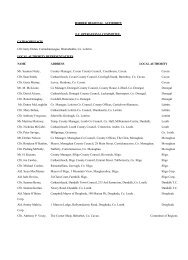downloads/RPGs/Border Regional Authority RPGs 2010-2022.pdf
downloads/RPGs/Border Regional Authority RPGs 2010-2022.pdf
downloads/RPGs/Border Regional Authority RPGs 2010-2022.pdf
You also want an ePaper? Increase the reach of your titles
YUMPU automatically turns print PDFs into web optimized ePapers that Google loves.
<strong>Border</strong> <strong>Regional</strong> <strong>Authority</strong> Planning Guidelines <strong>2010</strong> – 2022 – CHAPTER 1<br />
Environment, Heritage and Local Government. The HDA follows the key procedural stages as laid out in EU<br />
and National Guidance. The stages are as follows:<br />
• Stage 1: Screening;<br />
• Stage 2: Appropriate Assessment;<br />
• Stage 3: Assessment of alternative solutions;<br />
• Stage 4: Assessment where no alternative solutions exist and where adverse impacts remain.<br />
The policies and objectives of the <strong>RPGs</strong> have also been systematically assessed through the Habitats<br />
Directive Assessment to determine their impact on the Natura 2000 network, both in-situ and ex-situ. The<br />
Habitats Directive Assessment Report is a supporting document which should be read and considered in<br />
parallel with these Guidelines.<br />
1.2 PURPOSE OF THE NEW REGIONAL PLANNING GUIDELINES<br />
A vision for the <strong>Border</strong> Region, and a number of strategic goals required to achieve that vision have been<br />
set out in Chapter 2. The revised Guidelines will provide a strategic planning framework to deliver the<br />
above, and will focus on the following key areas:-<br />
• A new <strong>Regional</strong> Settlement Strategy to structure and focus development potential across the<br />
Region;<br />
• An update of regional, county and key settlement estimates of population and housing needs,<br />
including specific estimates to be applied to future reviews of County Development Plans;<br />
• A new <strong>Regional</strong> Economic Strategy which outlines the future enterprise potential and related<br />
development, as and when they arise during the course of the life of the next <strong>Regional</strong> Planning<br />
Guidelines;<br />
• Those strategic infrastructure investments likely to be made within the life of each RPG, or that<br />
have been identified in national level plans, and need to be provided for in the longer term in more<br />
local level planning;<br />
• Updating the approach with regard to other important objectives for RPG’s, in relation to for<br />
example, climate change, sustainable development etc.<br />
• Carrying out of a complementary high-level Strategic Environmental Assessment, Appropriate<br />
Assessment (AA) and Strategic Flood Risk Assessment of the selected regional settlement and<br />
infrastructure strategies, and outlining where critical issues may arise to be dealt with in<br />
city/county plans<br />
The main objective of the <strong>Regional</strong> Planning Guidelines is to provide a long-term strategic planning<br />
framework for the development of the <strong>Border</strong> Region. In doing this, Section 23 (4) (a) of the Planning and<br />
Development Act States that:-<br />
‘When making regional planning guidelines the regional authority shall take account of the proper planning<br />
and sustainable development of the whole of the region to which the guidelines relate, the statutory<br />
obligations of any local authority in the region and any relevant policies or objectives for the time being of<br />
the Government or of any Minister of the Government, including any national plans, policies or strategies<br />
specified by the Minister to be of relevance to the determination of strategic planning policies’<br />
It is expected that new <strong>Regional</strong> Planning Guidelines will be adopted by mid-<strong>2010</strong> and will be the subject of<br />
a further review in 2016.<br />
1.3 SUMMARY PROFILE of THE BORDER REGION<br />
The <strong>Border</strong> Region derives its name from its location in relation to Northern Ireland (NI). It comprises the six<br />
counties of Donegal, Sligo, Leitrim, Cavan, Monaghan and Louth, which form the border with Northern<br />
Ireland, providing the key interface between the two jurisdictions.<br />
2






